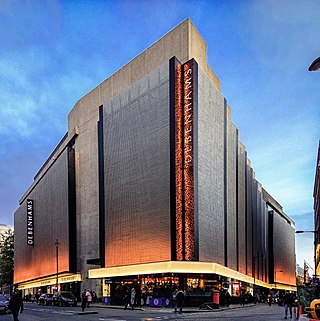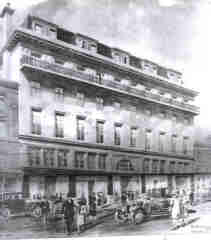Related Research Articles

Debenhams plc was a British department store chain operating in the United Kingdom, Denmark and the Republic of Ireland. It was founded in 1778 as a single store in London and grew to 178 locations across those countries, also owning the Danish department store chain Magasin du Nord. In its final years, its headquarters were within the premises of its flagship store in Oxford Street, London. The range of goods sold included middle-to-high-end clothing, beauty, household items, and furniture.

Allders was an independent department store operating in the United Kingdom.

House of Fraser is a British department store group with 44 locations across the United Kingdom, which is now part of Frasers Group. It was established in Glasgow, Scotland in 1849 as Arthur and Fraser. By 1891, it was known as Fraser & Sons. The company grew steadily during the early 20th century, and after the Second World War a large number of acquisitions transformed the company into a national chain.

Debenhams Ireland was a national chain of department stores in Ireland, that was owned ultimately by Debenhams plc. It was largely based on the former Roches Store chain, though after that business divested its grocery units.
Cavendish House is Cheltenham's oldest and leading department store, located on The Promenade. Its establishment was of great significance for Cheltenham's future reputation as a leading shopping centre. Known as 'Cavendish House' from its early days, its name was officially adopted with the registration of a limited liability company in 1883. The store became part of the House of Fraser group in 1970.
Owen Owen was a Liverpool-based operator of department stores in the United Kingdom and Canada. Beginning with a drapery shop in Liverpool, a chain of department stores was built up, often by taking over rival retailers. The company remained under Owen / Norman family control until the 1980s, and the brand ceased to be used in 2007.

Beales is an English department store chain, which currently operates 3 branches, in Peterborough, Poole and Southport. The former flagship store, Beales in Bournemouth, was established as The Fancy Fair by John Elmes Beale in 1881 and was the biggest department store in Dorset. The chain expanded through acquiring other department stores and continued to run two stores branded as Palmers in Great Yarmouth and Lowestoft until its closure.

Swan & Edgar Ltd was a department store, located at Piccadilly Circus on the western side between Piccadilly and Regent Street established in the early 19th century and closed in 1982.
United Drapery Stores, or UDS, was a British retail group that dominated the British high street from the 1950s to the early 1980s.

Marshall & Snelgrove was a department store on the north side of Oxford Street, London, on the corner with Vere Street founded by James Marshall. The company became part of the Debenhams group.

H. Binns, Son & Co. was a chain of department stores based in Sunderland, later purchased and absorbed by House of Fraser.
Edwin Jones was a large department store in Southampton, England founded in 1860 in East Street, Southampton with further stores established in Old Christchurch Road, Bournemouth, and Clinton Arcade, Weymouth. The business became part of the Drapery Trust, later a subsidiary of Debenhams, in 1928. The store was re-branded as Debenhams in 1973.
Drapery Trust formed in 1925 by Clarence Hatry, a notorious British financier. He had made his fortune in speculating on oil stocks, and had convinced investors to promote department stores and bring them under the management of a retail conglomerate. The business was acquired by Debenhams in 1927 and was run as a subsidiary until the 1970s.
Curl Brothers were a department store based in Norwich. The store later became part of the Debenhams chain.
Buntings was a large department store in Norwich, England, that became part of the Debenhams group.
Scottish Drapery Corporation was a holding company for a group of Scottish department stores and drapers.
Brights was a small group of department stores based in the South and South West of England.

Plummer Roddis was a chain of department stores based in the South of England which was acquired by the Drapery Trust, before being absorbed by its parent company Debenhams.

Colson's, later Dingle's and House of Fraser, was a department store located in Exeter, Devon, England. Located on the High Street, the store was founded in 1792, then expanded after damage in the Second World War. It was later purchased and grouped with Plymouth-based Dingles, taking their name, before becoming House of Fraser. The store closed in 2019, along with a number of other House of Fraser stores during financial difficulties at the group. The site was derelict for a number of years, before being renovated during 2022 by IHG Hotels & Resorts as a Hotel Indigo, including a restaurant named "Colson's" in recognition of the history of the building.
References
- ↑ "Bobbys stores part of a golden age of shopping". Thanetgazette.co.uk. Archived from the original on 30 October 2014. Retrieved 30 October 2014.
- 1 2 3 Stobart, Jon (2017). "Cathedrals of Consumption? Provincial Department Stores in England, c.1880–1930" (PDF). Enterprise & Society. 18 (4): 810-845. doi:10.1017/eso.2016.91. S2CID 157105045.
- ↑ Michael Behm (17 June 2012). "COSGB". Cosgb.blogspot.co.uk. Retrieved 30 October 2014.
- ↑ Parliament, New Zealand (1919). "Board of Trade Bill": 539. Parliamentary Debates. House of Representatives. New Zealand Parliament.
{{cite journal}}: Cite journal requires|journal=(help) - ↑ "Furnishing. Bobby & Co., Ltd". Collections.vam.ac.uk. Retrieved 30 October 2014.
- ↑ Michael Behm (17 June 2012). "COSGB". Cosgb.blogspot.co.uk. Retrieved 30 October 2014.
- ↑ "Debenhams". Statements of the New York Stock Exchange. 1928. p. 2.
- ↑ Corina, Maurice (1978). Fine Silks & Oak Counters: Debenhams 1778-1978 (First ed.). London: Hutchinson Benham. p. 134. ISBN 0-09-134910-9.
- ↑ "Bobby's and Debenhams- a History in Exeter". Exeter Memories. Retrieved 15 April 2023.
- ↑ Tony Ovenden. "Thanet coast life". Thanetcoastlife.blogspot.co.uk. Retrieved 30 October 2014.
- ↑ George. M (9 September 2021). "Bobby's department store opens its doors in Bournemouth". Bournemouth Echo.